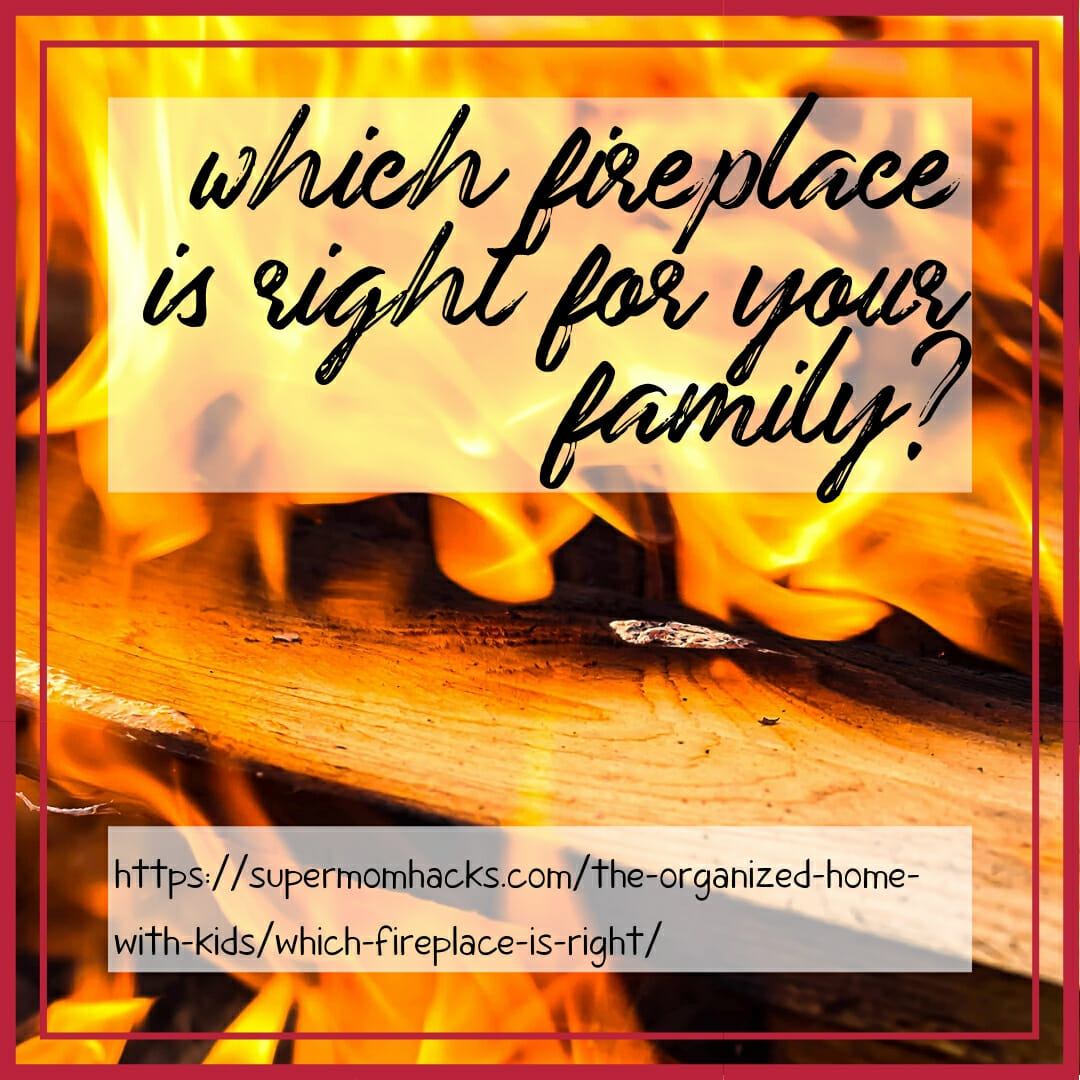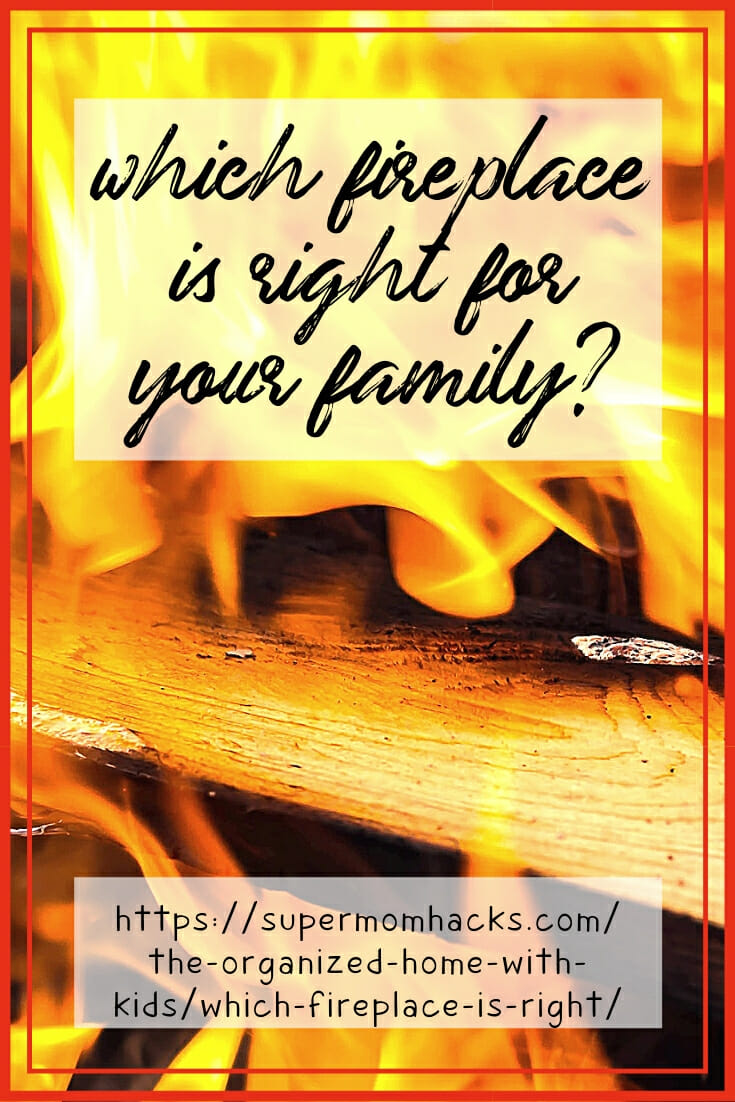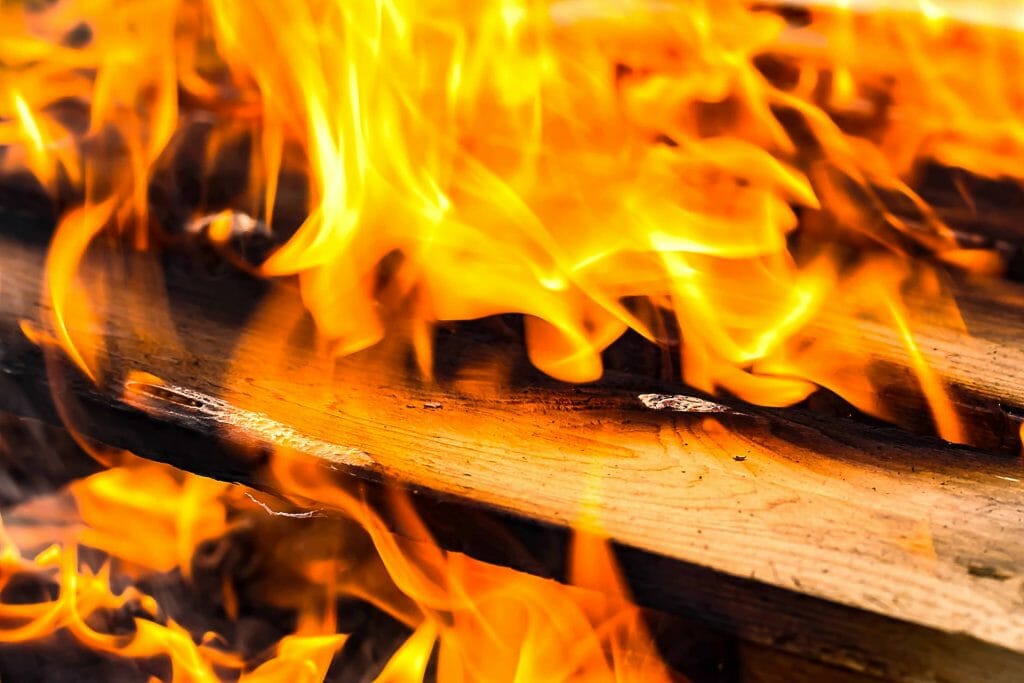Does your home have a fireplace – or do you wish it did? There’s something magical about the thought of the family getting cozy around the fireplace on chilly winter nights. But at the same time, as anyone with allergies or asthma will tell you, not every fireplace is right for everyone. So how do you decide which fireplace is right for your family?
Didn’t realize it was so complicated? Well, here’s what you need to know about the options in order to help your family make the right choice.

How to Choose Which Fireplace Is Right For You
This is a question we’ve considered since moving into our current home, which came with an old-fashioned wood-burning fireplace. Replacing it has been lower on our priority list than some other upgrades, but each year it gets closer to the top.
Why replace? We love the CONCEPT of an open fire, but for various reasons it’s not the right choice for our family. Still, maybe it is for yours:
1. Wood-burning fireplaces
Pros:
Wood-burning options are classic. There’s nothing quite so picturesque as gathering around a roaring fire during the winter, maybe enjoying popcorn and a cup of tea over family game night.
Wood fireplaces can be cost-effective. Rural landowners often have a ready source of fuel right in their backyard. (My widowed mama still lives on the mostly-wooded 20-acre parcel where I grew up, and every year she has to get dead and down trees out of the woods in order to maintain the perimeter nature trail my father created.) And since many older homes come with them, there are no startup costs.
Wood fireplaces give off heat. Not enough to warm your whole house, unless you have a wood furnace (as my parents’ home does in the basement), but enough to warm a room. (At least near the fireplace, anyway.) When I was a baby, a massive winter storm left my parents without power for a week. My mama and I survived by staying warm in front of the living-room fireplace while my dad was at work, and sleeping next to it at night.
Cons:
Beware what wood you buy. If you have to buy your wood, make sure you get “seasoned” firewood, which basically means it’s been sitting around for at least a year to dry out. Freshly-cut wood, or “green” wood, doesn’t burn well because of the sap and other moisture inside. Trying to burn green wood also creates excess smoke and soot, because it hasn’t dried out yet.
Wood fireplaces pose safety hazards. Kids and open flame are just a bad combination. As such, they aren’t the best choice for those with little babies crawling around, and they can provide an irresistible temptation to older children as well. Besides dangers from the actual flames, wood fires also produce particulate matter that is unhealthy for lungs – especially those of babies/toddlers, but also anyone with allergies or asthma. Over time, the smoke will also cause dirty marks on walls, ceilings, and furniture.
Wood-burning fireplaces require maintenance. The first home I owned, a condominium unit, had a wood-burning fireplace. I never once burned a fire in it due to my allergies. But the homeowner’s association rules still required that I get the chimney inspected (and if needed, cleaned) at least every other year, because of the safety hazards of NOT getting chimneys regularly cleaned. When you burn wood in a fireplace, the creosote and soot build up not only on the walls of your home, but also on the inside of your chimney. This buildup is highly flammable; let it build up too much, and you risk its becoming fuel for a chimney fire.
Options:
- Again, if you’re going to burn wood, you need to get chimney cleaned by a professional every year or two – and make sure that you never leave any children unattended near the fireplace! (Or leave the fire itself unattended, for that matter.)
- If you don’t want to burn wood in your fireplace, another option is to line up some decorative candles to burn on a winter night. This will give off barely any light and no heat, but will also be a lot less smoky.
- Make sure you only burn wood that’s been properly “seasoned” (allowed to sit and dry out for a year or more).
2. Gas fireplaces
Pros:
Less mess. Gas-burning fireplace inserts are a lot cleaner than wood-burning ones. In other words, they don’t release the lung-irritating particulate pollution into your home (or into the outdoor air via the chimney). This makes them a natural choice for those with sensitive lungs, including the very young. Gas inserts also save you the mess of dealing with chopped wood. Not to mention having to clean out the ashes. Or the fact that piles of wood in your basement/near your house attract mice and other critters (been there, done that).
Greater safety. No more worrying about little ones getting at open flames, or about stray sparks starting a house fire!
Greater heating efficiency. Wood-burning fireplaces lose up to 85% of their heat up the chimney. While not all gas fireplace inserts are designed to heat a room (many are purely decorative), those that ARE designed for zone heating are much more energy-efficient than wood at what they do. Using one in the room(s) where your family spends the most time can even allow you to turn down the thermostat elsewhere in your home, thereby saving money!
Cons:
The charm factor. Gas-burning fireplace inserts just aren’t as charming as an “old-fashioned” wood-burning fireplace. You can’t pop popcorn or toast marshmallows over them, and you won’t hear them crackle and sizzle.
The heat factor. If you’re house-hunting and see a home with a gas fireplace insert, find out how old it is, and whether it’s purely decorative. If it’s more than a few years old, chances are good that it’s designed to be pretty, but won’t do a thing to warm your winter.
You still have to maintain them. No, you won’t need to hire a chimney sweep each year. But you DO still need to get them serviced annually.
Options:
- Your first consideration is whether your home already uses natural gas. If so, you’ll get a fireplace insert that runs off natural gas. If not, you’ll need one that runs off propane; you’ll also need a large external propane tank, if you don’t already own one. (For reference, our tank, which can accommodate our gas stove and a fireplace, is 120 gallons. Right now, running only our propane stove off of it, we get it filled every 13-14 months.)
- Your second consideration is whether you want a fireplace that’s purely decorative, or one that actually gives off heat. The latter is more expensive to install, and more expensive to maintain (because it will use more gas). But when you consider the potential savings on your overall heating costs (because you can lower the whole-house thermostat while you’re enjoying the gas insert’s heat in your family room), you’ll save money in the long run.
- When choosing gas fireplaces designed for zone heating, a reputable dealer can help you choose between the different venting systems available and select the one that works best for your family’s needs and compliance with local laws.
Does your family have a fireplace? Gas or wood? What factors helped you decide which fireplace is right for your family? Let us know in the comments!
If you enjoyed this post on choosing which fireplace is right for your family, why not share it with others by pinning this image?

NOTE: This site contains affiliate links. I may earn a small commission from any purchases made through affiliate links, at no additional cost to you. For more information, please read the full disclosure/privacy policy.


I love knowing that compared to wood-burning fireplace inserts, gas fireplace inserts are much cleaner. To put it another way, you said that they don’t let the lung-irritating pollution particles into your house or, through the chimney, into the outside air. Well, I think you just convinced me to hire an indoor heating service ASAP and get a fireplace installed just in time for the holiday festivities.
It’s not always QUITE so immediate, but I hope you were able to get something sorted out in time for the new year! Ours took awhile to come in once we’d ordered it, and then getting all the pieces lined up took a little while longer, but we SO love our insert!!!